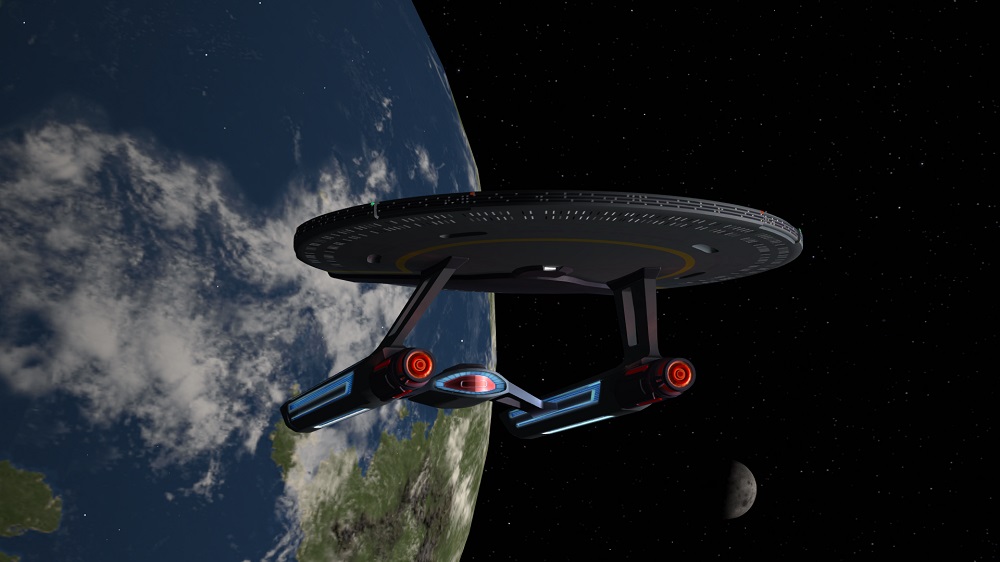California Class
Created by Fleet Admiral Luzol Targaryen on Tue Aug 1st, 2023 @ 11:49am
California Class
 | |
| Affiliation: | Federation Starfleet |
| Service Period: | 24th - 25th Centuries |
| Length: | 535 meters |
| Width: | 330 meters |
| Height: | 121 meters |
| Mass: | 2,100,000 metric tons |
| Decks: | 20 |
| Crew: | 600 personnel |
| Speed: | Warp 9.6 |
| Armament: | Phaser Arrays Photon Torpedo Launchers |
| Defenses: | Shields |
| Auxiliary craft: | Starfleet Shuttlecraft |
Overview
The 24th Century saw one of the largest periods of uninterrupted peace for the worlds of the United Federation of Planets. With peace considered attainable with the Klingons and the Romulans keeping to themselves, Starfleet Exploratory Command authorized wide-scale exploratory initiatives on the scale of the birth of the Federation era. Realizing that some of Starfleet's designs were not on par with the demands of this new age. With the Galaxy Class Development Project announced in 2343, Starfleet realized that an entire generation of vessels would be needed to support their new cutting edge explorer and many new ships were authorized for construction.
Heavily inspired by its Galaxy and Nebula Class cousins, the California Class was designed to include many of the same technologies as these larger vessels in its construction. Intended as a replacement for the Oberth Class, the California was designed to fulfill specialized secondary mission assignments on behalf of the Federation. While not a front-line starship, the California and its sisters are capable, versatile vessels where mission success often hinges on the capabilities of their specialty crews.
Capabilities
Design wise the California Class shares a similar aesthetic to other members of Starfleet, but the overall appearance deviates from its counterparts. California Class ships have a round saucer section with the nacelle pylons attached to the ventral surface of the ship. Accessible via turbolift or Jeffries Tube, the small secondary hull is mounted between the nacelles themselves. Unlike most Federation vessels the nameplate for California Class ships is located aft of the Bridge Module on the primary hull. While armed with Phasers and Torpedo Launchers integrated into the primary hull, the California is not an ideal choice for combat.
Influenced by the Galaxy Class Development Project, many of the same systems installed on the Galaxy Class can be found aboard the California Class. Located in the secondary hull, the Warp Core of the California Class runs the entirety of the section and incorporates inverted plasma distributors in its construction. The California was capable of traveling at a maximum safe speed of Warp 8, but could exceed this speed for short bursts in a genuine emergency at extreme risk to the ship and crew. Because of the unique arrangement of the Warp Core assembly, ejection of the Warp Core requires the approval of two senior officers using isolinear keycards to signify their confirmation.
California Class vessels feature three shuttlebays and storage for multiple auxiliary craft - including a Captain's Yacht attached to the underside of the primary hull. While a large craft, California Class vessels have a diverse assortment of equipment installed and, while specialized, a large crew complement. Due to these factors, space is a premium aboard a California Class ship and the accommodations for the crew suffer as a result. While Senior Officers have their own quarters, lucky Junior Officers (and some unlucky Officers) have small or even shared cabins. Most Junior Officers and enlistees aboard the California Class have bunks available to them located in the primary hull lower deck corridors and communal lavatory facilities.
Refits and Variants
The California Class starship was designed to undertake secondary missions on behalf of Starfleet, following up on the missions of larger Starfleet vessels for situations that require a long-term investment. To support these missions, several variants of the California Class have been constructed to fulfill specialist assignments on behalf of Starfleet. Styled by the departmental color most associated with the responsibilities of the ship, the variants include:
Mission Profiles
Colonial Support, Crisis and Emergency Response, Logistical/Quartermaster. Due to the specialized nature of the California Class, the mission profiles for vessels of this class are often limited. While California Class ships are numerous many experienced personnel tend to avoid applying to these types of vessel due to the stigma of serving aboard.
Naming Conventions
California Class Starships are frequently named in honor of settlements and historic persons within the state of California in the United States on Earth.
Notable Starships
U.S.S. California, Class Prototype U.S.S. Axca U.S.S. Bradbury U.S.S. Carlsbad U.S.S. Cerritos U.S.S. Inglewood U.S.S. Merced U.S.S. OaklandCategories: No categories found